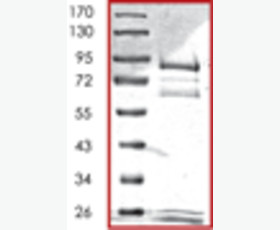Recombinant Human GTP-Binding Protein Rheb/RHEB
| Product name: | Recombinant Human GTP-Binding Protein Rheb/RHEB |
| Source: | E. coli |
| Purity: | Greater than 95% as determined by reducing SDS-PAGE. |
| Buffer Formulation: | Lyophilized from a 0.2 μm filtered solution of 20mM Tris, 10mM GSH, pH 8.0. |
| Applications: | Applications:SDS-PAGE; WB; ELISA; IP. |
| Storage: | Avoid repeated freeze/thaw cycles. Store at 2-8 oC for one month. Aliquot and store at -80 oC for 12 months. |
| UOM: | 100ug/50ug/200ug/1mg/1g |
| Source | E. coli |
| Description | Recombinant Human GTP-Binding Protein Rheb is produced by our E.coli expression system and the target gene encoding Met1-Met184 is expressed with a GST tag at the N-terminus. |
| Names | GTP-Binding Protein Rheb, Ras Homolog Enriched in Brain, RHEB, RHEB2 |
| Accession # | Q15382 |
| Formulation | Lyophilized from a 0.2 μm filtered solution of 20mM Tris, 10mM GSH, pH 8.0. |
| Shipping |
The product is shipped at ambient temperature. |
| Reconstitution |
Always centrifuge tubes before opening. Do not mix by vortex or pipetting. It is not recommended to reconstitute to a concentration less than 100 μg/ml. Dissolve the lyophilized protein in ddH2O. Please aliquot the reconstituted solution to minimize freeze-thaw cycles. |
| Storage |
Lyophilized protein should be stored at < -20°C, though stable at room temperature for 3 weeks. Reconstituted protein solution can be stored at 4-7°C for 2-7 days. Aliquots of reconstituted samples are stable at < -20°C for 3 months. |
| Purity |
Greater than 95% as determined by reducing SDS-PAGE. |
| Endotoxin | Less than 0.1 ng/µg (1 IEU/µg) as determined by LAL test. |
| Amino Acid Sequence |
MPQSKSRKIAILGYRSVGKSSLTIQFVEGQFVDSYDPTIENTFTKLITVNGQEYHLQLVDTAGQD EYSIFPQTYSIDINGYILVYSVTSIKSFEVIKVIHGKLLDMVGKVQIPIMLVGNKKDLHMERVIS YEEGKALAESWNAAFLESSAKENQTAVDVFRRIILEAEKMDGAASQGKSSCSVM
|
| Background | GTP-Binding Protein Rheb (RHEB) is a member of the small GTPase superfamily and encodes a lipid-anchored, cell membrane protein with five repeats of the RAS-related GTP-binding region. Highest levels of RHEB can be found in the skeletal and cardiac muscle, and it is vital in the regulation of growth and cell cycle progression due to its role in the Insulin/TOR/S6K signaling pathway. RHEB stimulates the phosphorylation of S6K1 and EIF4EBP1 through activation of mTORC1 signaling, and it activates the protein kinase activity of mTORC1. RHEB has GTPase activity and shuttles between a GDP-bound form and a GTP-bound form, farnesylation of the protein is required for this activity. |














